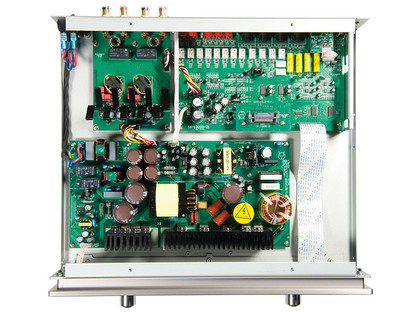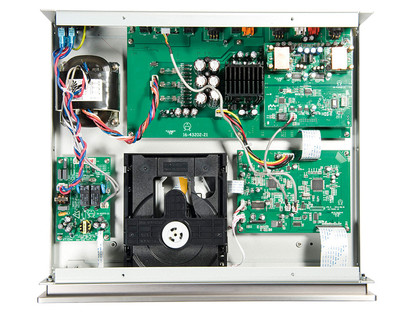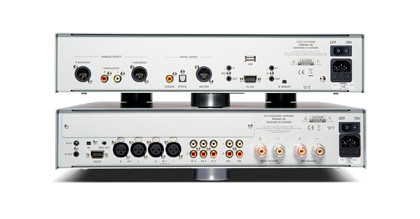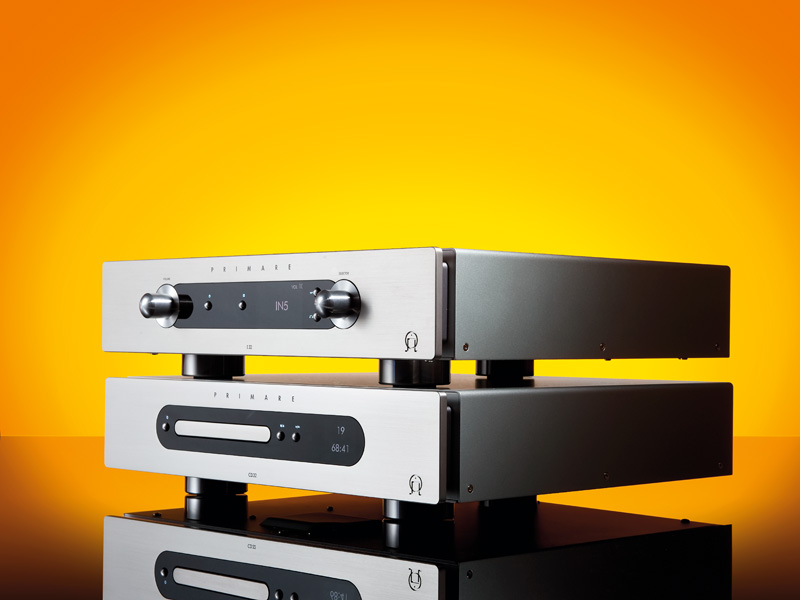TechRadar Verdict
Pros
- +
Smart and slick
- +
Balanced output
- +
Selectable upsampling
- +
Gorgeous sound full of detail
- +
Precise timing
- +
Effortless musicality
Cons
- -
Cheesy remote control
- -
No WAV or FLAC
- -
Only five line inputs and no phono
Why you can trust TechRadar
Primare has at last updated its distinctive CD player and matching amp for 2011 and on the amp especially, it has gone to town. From the outside the CD32 and I32 don't look wildly different from previous Primare offerings, so what's new?
Most obviously, the I32 amplifier is a whole new design, using as it does a Class D topology. As Primare is at pains to point out, this isn't digital amplification, but it is a switching approach, modulating the power applied to the output at a fast rate rather than tracking it in traditional analogue manner.
The CD player is less revolutionary, but still has some new features, including a USB-A socket for connecting a memory stick, music player or hard disc.
Quick-switch act
Class D amplifiers aren't new (the idea goes back decades) and they aren't exactly rare in 2011, either. That said, there aren't all that many individual designs.
Many manufacturers are using bought-in modules to do most of the hard work, such as Bang and Olufsen's successful Icepower modules. Primare, however, has gone it alone and developed a proprietary circuit called UFPD, short for Ultra Fast Power Device.
'Fast' is very much to the point in Class D circuits, because when you are switching a signal on and off rapidly, any departure from truly instantaneous on/off transitions upsets the whole performance. Primare's claim is that the unusually fast switching achieved in UFPD allows more consistent feedback to be applied to the circuit.
Sign up for breaking news, reviews, opinion, top tech deals, and more.

In the great majority of modern amplifiers, linear and switching, feedback is used to turn a basically accurate circuit into a highly accurate one, but it can be a double-edged sword. Primare has arranged things so that the feedback applied to the circuit is the same at all frequencies, which is generally a safe route to consistent performance.
As a result, we're told the specification of this amplifier over the whole audio range is at least as good as previous Class D designs and in the treble a lot better. In addition, performance is more assured into real loudspeaker loads.
One of the unavoidable drawbacks to switching amplifer design is the need to filter off the high-frequency 'carrier' signal so that it doesn't fry tweeters. Trouble is, the filter tends to be a bit intrusive on the audio signal path. It increases the output impedance, which in turn gives response variations into real-world loudspeakers: sometimes it distorts the audio signal, too.
The I32 still has an output filter, but it's been designed as part of the overall amplifier circuit rather than a bolt-on extra and so it has a less intrusive effect. Output impedance is lower than from most switching amps, especially in the treble, and response is therefore much closer to flat – and, of course, the damping effect on a loudspeaker is better.
Other benefits of Class D still apply, including better efficiency than a conventional linear amplifier, in turn reducing the requirement for large heatsinks (there are still heatsinks but they're small for the I32's 120-watt rating) and allowing Primare to build the amp into an unvented case.
With dust being one of the biggest enemies of electronic reliability – a blanket of dust is the best way of getting components to overheat – that can only be a good thing.
Discs and transistors
The CD32 much more closely resembles CD players we've come to love over the years, with a conventional drive mechanism, high-quality sample-rate converter, digital filter and DAC chips of recent vintage, as well as a linear power supply based on an R-core transformer.

One rather unusual feature is the use of discrete transistors for the current-to-voltage convertor which follows the DAC. This isn't unique, but most CD players use an op-amp at this point. Many of them achieve very good results too, but Primare isn't alone in believing that discrete transistors still have advantages if done right.
The relevant circuits are implemented with surface-mounted components on small circuit boards, screened with solid copper plates. Features on the CD32 include balanced analogue outputs and also a balanced digital output (AES/EBU), alongside the usual phono and S/ PDIF versions.
The USB input we mentioned is a nice touch, though we were disappointed to find that it only recognises MP3 and WMA files. WAV and/or FLAC compatibility would be nice.
With memory prices for SD cards and USB sticks now down to barely £1 per GB (60p per hour for CD-quality WAV format), surely MP3's days in any audiophile environment must be numbered?
The I32 doesn't offer a vast array of features in standard form, though we certainly approve of the two pairs of balanced inputs. A total of just five line inputs isn't enormously generous by current standards and there's no option to add a phono stage.
The clever part, though, is that Primare has announced (though not yet made available) a 'media upgrade' for the amp, which adds a host of latest-generation features: digital inputs of all flavours, Ethernet (and wireless) network connectivity and hence media and internet radio compatibility.
We do have one quibble, though, and it concerns the operation of the CD player. The amp responds exactly as one would expect to front panel and remote controls and it's no trouble at all. The CD player has several functions only available from the remote and we're not sold on it. For one thing, it's just not the sort of device we'd want to have alongside four grand's-worth of classy hi-fi . It looks and feels every bit like the remote for a £200 telly from Tesco.

Also less then ideal is the fact that, although the CD32 can upsample to 48kHz (unusual!), 96kHz, or not at all, it's only mentioned in passing in the instructions. Anyway, both that and the remote itself are addressable concerns and we very much hope that Primare will consider our comments.
Making sweet music
Our first impression is of exceptionally assured sound, with heaps of detail, beautifully neutral tonal balance and really gorgeous, tactile solidity. Close your eyes and you're convinced that with just a couple of steps towards the speakers you'll be in danger of impaling yourself on the end of a cello spike or copping a drumstick on the nose.
Images are simply superb, immaculately spread out in all directions and utterly stable, fully vindicating the 80-year-old confidence trick that is stereo. It's a finding we repeated over and over as we trawled through the widest selection of recordings, old and new, from jazz to rock to classical to unclassifiable.
Cue up some operatic monster and the panoply of 200 players and singers is there before you: play the simplest voice and guitar ballad and the intimacy is immediate.
The specifics
We did make an effort to check the usual hi-fi specifics, though we'd struggle to identify any we could criticise.
Bass ticks all the boxes, with extension, weight, solidity, tuning and kick all first-class. Midrange is natural and lifelike with no coloration we could detect. Treble is open, clear and pure with entirely believable decay into ambience and not a hint of exaggeration or spit when things get busy.
There's lots of power on tap and at no point did we feel the amp was struggling even at levels barely below overload.
Timing? Like an atomic clock. The CD player's upsampling options make very little difference: we slightly preferred 96kHz, but not by much. Perhaps, just perhaps, we slightly preferred the unbalanced connection to balanced, but that could simply have been our cables.
Sonically, we have nothing but praise for these newcomers and that would still be true if they were considerably more expensive. Now, if Primare could just sex up that remote control...
Follow TechRadar Reviews on Twitter: http://twitter.com/techradarreview
